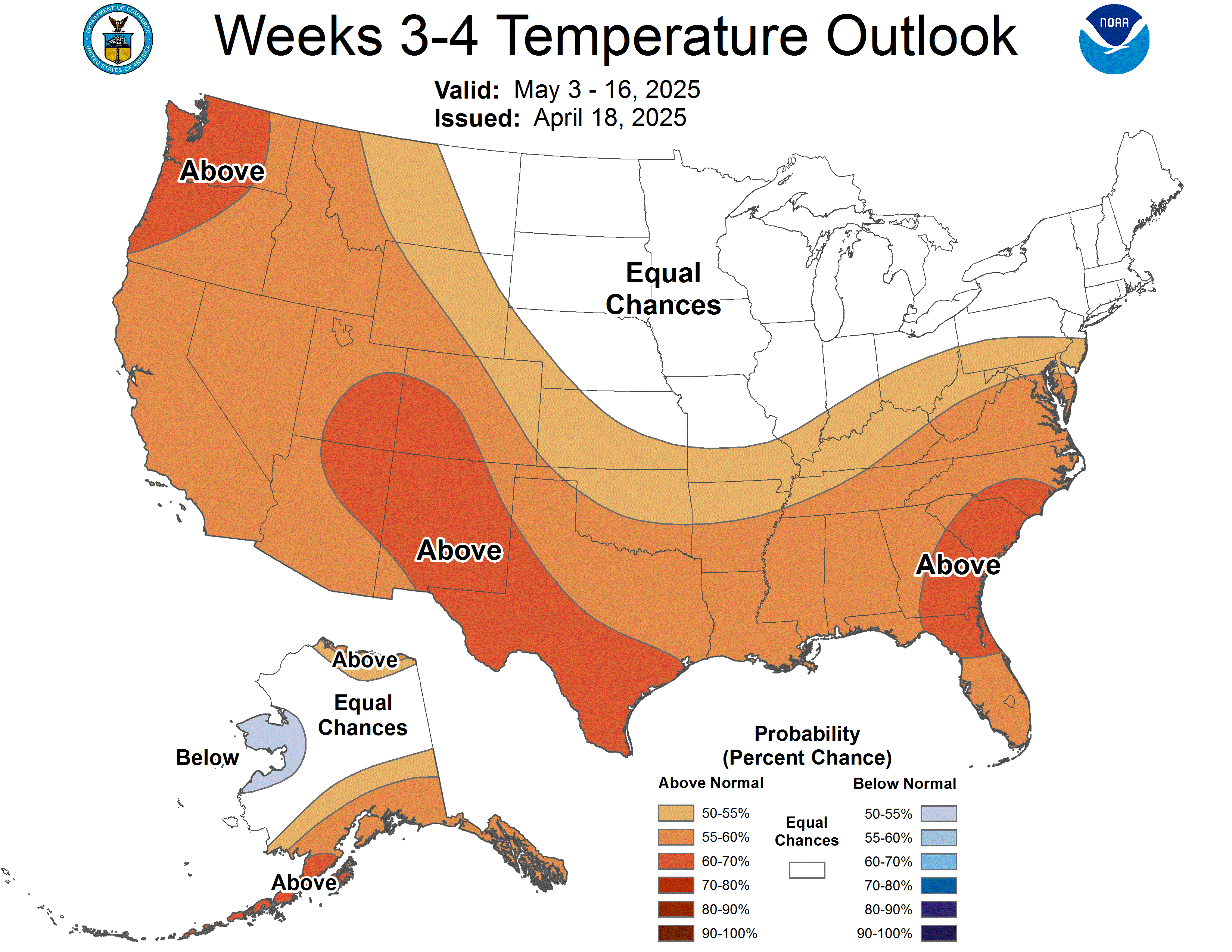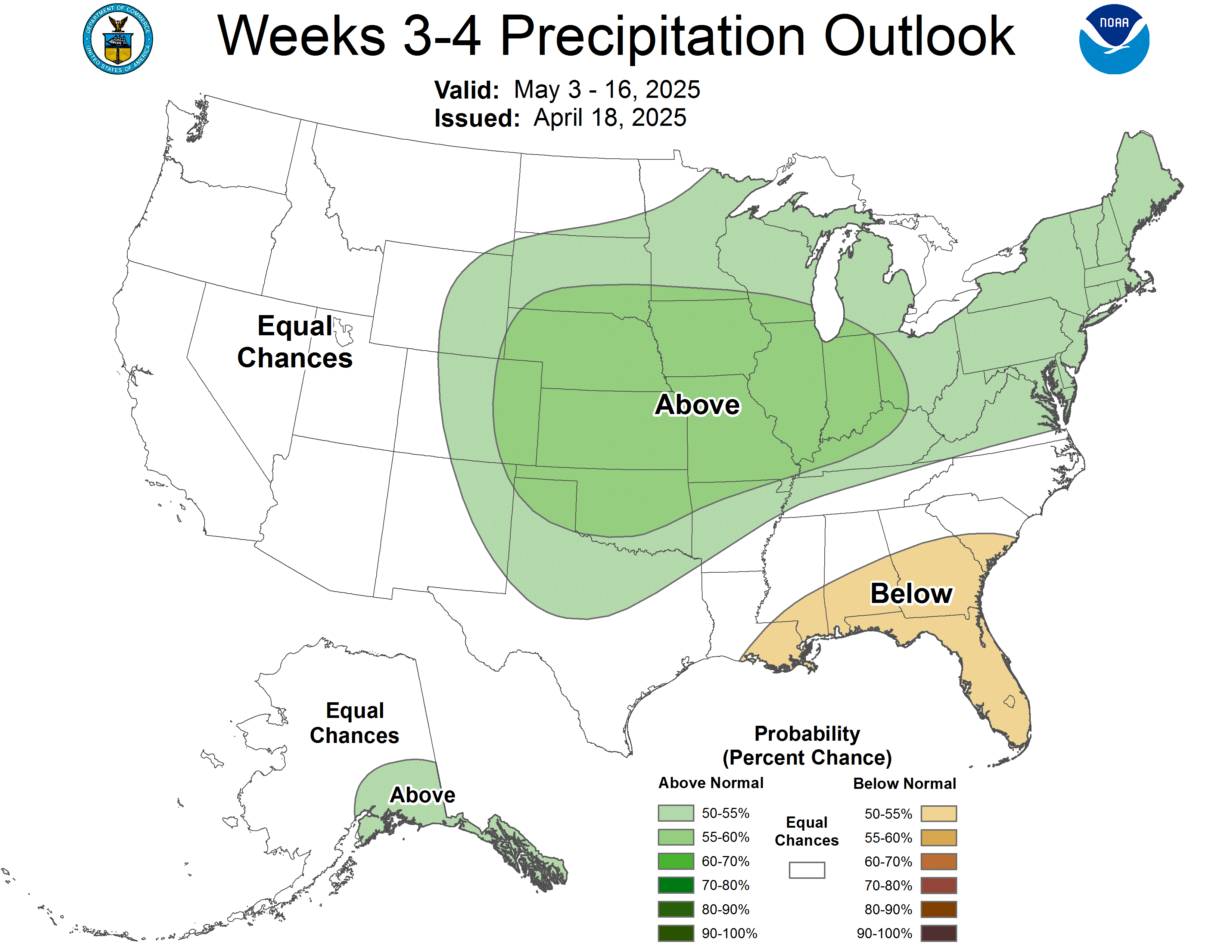|
|
General Information
|
Forecast Tools
|
Verification
|
Related Outlooks
|
About Us
|
Contact Us
|
As of the May 19th, 2017, release, Week 3-4 outlooks precipitation outlooks are experimental, whereas the temperature outlooks are operational. Both are issued Friday between 3pm & 4pm Eastern Time.
|
|
|
HOME>
Outlook Maps>
Week 3-4 Outlooks
|
|
|
Week 3-4 Outlooks
|
Valid: 12 Apr 2025 to 25 Apr 2025
Updated: 28 Mar 2025
|
|
Temperature Probability

|
Precipitation Probability

|
Experimental Week 3-4 500mb Outlook
|
|
Click HERE for info about how to read Week 3-4 outlook maps
|
|
Prognostic Discussion for Week 3-4 Temperature and Precipitation Outlooks
NWS Climate Prediction Center College Park MD
300PM EST Fri Mar 28 2025
Week 3-4 Forecast Discussion Valid Sat Apr 12 2025-Fri Apr 25 2025
La Nina conditions are currently present with equatorial sea surface temperatures (SSTs) near-to-below average in the central Pacific Ocean and above-average in the eastern Pacific Ocean. Above average outgoing longwave radiation (OLR) is observed around the Date Line and western Pacific, while below-average OLR is evident in parts of Indonesia, Southeast Asia, and the Philippines and in the eastern Pacific. The Madden Julian Oscillation (MJO) index indicates a slow eastward propagating MJO after it entered the Indian Ocean in early March and accelerated eastward to the West Pacific during the past week. The GEFS dynamical forecast shows the MJO continuing to propagate eastward through early April but the ensemble spread is large. The ECMWF model depicts a weak MJO during the next two weeks. The Weeks 3-4 Temperature and Precipitation Outlooks are based primarily on operational dynamical model guidance, including the GEFSv12, CFSv2, ECMWF, and JMA, as well asimpacts of the MJO, ENSO, and the predicted evolution of the pattern from the Week-2 forecast.
Dynamical model 500-hPa height anomaly forecasts during Weeks 3-4 show a fairly consistent evolution from Week-2 forecasts. A blend of the ECMWF and GEFSv12 500-hPa height pattern forecasts, plus a contribution from the Multivariate Linear Regression (MLR) height forecast based on the RMM index, ENSO, and decadal trends, predicts near to above average height anomalies across most of the contiguous United States (CONUS). A strong ridge and positive 500-hPa height anomalies are predicted over the Bering Sea, while a weak trough is forecast over Mainland Alaska. Near normal 500-hPa heights are predicted over Hawaii.
Enhanced chances for above normal temperatures are predicted for most of the western, southern, and eastern CONUS due to the anticipated mid-level ridging, generally above-normal 500-hPa height anomalies. The forecast is further supported by most of the dynamical temperature forecast tools. Probabilities favoring above normal temperatures reach 60% for parts of southern California and southwestern Arizona. Equal chances (EC) of above and below normal temperatures are indicated for the remainder of the CONUS, in part due to uncertainty in dynamical model temperature forecasts. Below normal temperatures are favored over portions of western Mainland Alaska, supported by the experimental ensemble subsampling and manual blend temperature forecast tools.
The Weeks 3-4 Precipitation Outlook favors below median precipitation over parts of western CONUS, under above normal 500-hPa heights. A majority of the dynamical guidance favors a tilt toward above median precipitation over portions of the Southern Plains and Lower Mississippi Valley. Below normal precipitation is also favored over parts of the Southeast, supported by most dynamical precipitation forecast tools. Above normal precipitation chances are elevated over central and eastern Mainland Alaska and southeast Alaska, due to a weak trough over the state, and consistent with most precipitation forecast tools.
Above-average SSTs and dynamical model guidance favor above-normal temperatures across Hawaii during Weeks 3-4. Above-average precipitation is weakly favored across the islands, with most model guidance depicting weak troughing to the west.
| Temperature | Precipitation |
| FCST | FCST |
| Hilo | A70 | A55 |
| Kahului | A70 | A55 |
| Honolulu | A70 | A55 |
| Lihue | A70 | A55 |
Forecaster: Luke He
The next week 3-4 outlook will be issued on Friday, Apr 04, 2025
These outlooks are based on departures from the 1991-2020 base period
These are two category outlooks and differ from official current three category outlooks currently used for the monthly and seasonal forecasts.
The shading on the temperature map depicts the most favored category, either above-normal (A) or below-normal (B) with the solid lines giving the probability ( >50%) of this more likely category (above or below).
The shading on the precipitation map depicts the most favored category, either above-median (A) or below-median (B) with the solid lines giving the probability ( >50%) of this more likely category (above or below).
In areas where the likelihoods of 2-week mean temperatures and accumulated precipitation amounts are similar to climatological probabilities, equal chances (EC) is indicated.
|
|
|
|
An ASCII (w/ HTML markup tags) text version of the written forecast is available.
|
|
|


